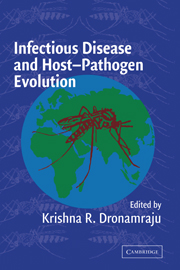Book contents
- Frontmatter
- Contents
- List of Contributors
- Introduction
- PART ONE J. B. S. HALDANE
- PART TWO MALARIAL PARASITES
- PART THREE OTHER PARASITES
- 7 Influenza Evolution
- 8 Free-Living to Freewheeling: The Evolution of Vibrio cholerae from Innocence to Infamy
- 9 Evolutionary Dynamics of Daphnia and Their Microparasites
- 10 Human Susceptibility to Visceral Leishmaniasis (Leishmania donovani) and to Schistosomiasis (Schistosoma mansoni) Is Controlled by Major Genetic Loci
- PART FOUR GENETIC AND EVOLUTIONARY CONSIDERATIONS
- Index
- Plate Section
- References
9 - Evolutionary Dynamics of Daphnia and Their Microparasites
Published online by Cambridge University Press: 10 August 2009
- Frontmatter
- Contents
- List of Contributors
- Introduction
- PART ONE J. B. S. HALDANE
- PART TWO MALARIAL PARASITES
- PART THREE OTHER PARASITES
- 7 Influenza Evolution
- 8 Free-Living to Freewheeling: The Evolution of Vibrio cholerae from Innocence to Infamy
- 9 Evolutionary Dynamics of Daphnia and Their Microparasites
- 10 Human Susceptibility to Visceral Leishmaniasis (Leishmania donovani) and to Schistosomiasis (Schistosoma mansoni) Is Controlled by Major Genetic Loci
- PART FOUR GENETIC AND EVOLUTIONARY CONSIDERATIONS
- Index
- Plate Section
- References
Summary
INTRODUCTION
Haldane (1949) was one of the first to speculate that the genetic outcome of parasitic interactions may have profound implications, in particular, that frequency-dependent selection on host and parasite polymorphisms can maintain genetic variation and promote sexual reproduction. Much theoretical work since then has supported his early insights: dynamic genetic polymorphisms or arms races are a common outcome of computer simulations of host–parasite coevolution. Recent theory now prompts us to ask precise questions about parasite-associated dynamics: Do host and parasite alleles cycle with regularity or as bursts followed by long periods of stasis? Do arms races result from directional selection on mutational input or does selection maintain alleles to antiquity (Hill et al., 1992; Hughes and Nei, 1992; Stahl et al., 1999)? The other major line of theory on host–parasite interactions, also foreshadowed by Haldane, concerns the evolution of virulence (the damage to the host caused by parasites), and this work has now developed explicit predictions concerning the conditions under which parasites ought to evolve towards doing greater or less harm to their hosts (Anderson and May, 1982; Ewald, 1983).
Probing these questions and predictions will shed light on the evolutionary significance of parasitism as envisioned by Haldane (1949) and others, because the exact tempo, mode, and outcome of selection matter if we are to properly evaluate the evolutionary significance of parasitism. However, empirical evidence lags behind theory, and it remains uncertain just how widespread and strong is genetic change associated with parasitic interactions in the wild.
- Type
- Chapter
- Information
- Infectious Disease and Host-Pathogen Evolution , pp. 222 - 240Publisher: Cambridge University PressPrint publication year: 2004
References
- 2
- Cited by



